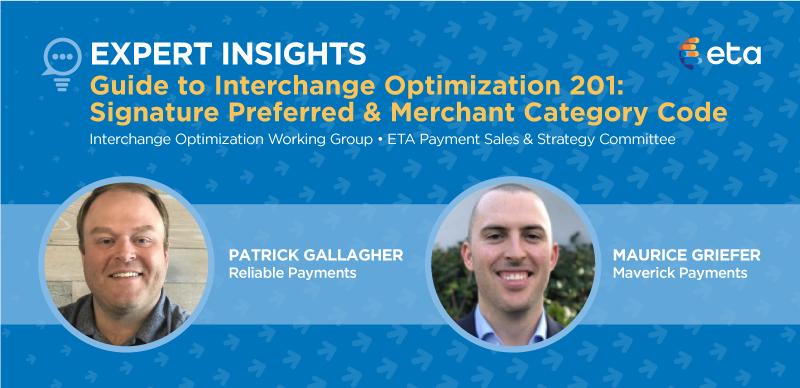ETA Expert Insights: Guide to Interchange Optimization 201: Signature Preferred & Merchant Category Code

Interchange Optimization Working Group • ETA Payment Sales & Strategy Committee
By Patrick Gallagher, Reliable Payments and Maurice Griefer, Maverick Payments
In our continuing effort to educate the ETA community and beyond on the intricacies of interchange optimization, we invited Patrick Gallagher of Reliable Payments and Maurice Griefer of Maverick Payments, members of ETA’s Payments Sales and Strategy Committee, put this article together to go deeper into interchange optimization. While interchange optimization is primarily thought of as Level II and Level III payment processing, there are additional niche categories such as enhancing Signature Preferred cards and ensuring the correct merchant category code (MCC) for your merchants.
SIGNATURE PREFERRED CARDS
With all this talk about Level II and Level III processing, it is important to note that there is more to interchange optimization than just getting a better rate for Purchasing, Corporate, and Government credit cards. Another common card type that we see is Signature Preferred. Banks issue Signature Preferred cards are issued by the banks to customers who typically spend between $50K and $250K per year on these cards. Signature Preferred can be issued to consumers or businesses, depending on their banking relationship, and include perks such as extended warranties and no annual fees.
Signature Preferred cards, however, can be costly to merchants. Businesses that use them could cause merchants to pay high interchange rates if the rate downgrades to the dreaded Commercial Standard rate of 2.95%. Like the other business cards on the market, Signature Preferred cards can be downgraded due to lack of enhanced data being provided and other specific criteria not being met.
To prevent this downgrade, merchants should ensure that the transactions they process meet Customer Payment Service (CPS) requirements at a minimum and, at best, provide the same enhanced data that we have discussed for Level II and III processing. By using the correct technology and inputting the data in correctly, merchants are able to remit the full spectrum of data required to meet the Level II and III specifications. The rates on a Signature Preferred card can jump from 2.95% and $0.10, to 2.40% and $0.10 for a Retail CNP transaction, or even to 2.10% and $0.10 for Retail CP or B2B transactions.
Keeping informed of these sets of criteria will help any salesperson become a true consultant, eschewing the ways of the past in which only the transaction sales process was provided. But there is so much more to interchange than just remitting enhanced data.
MERCHANT CATEGORY CODE (MCC) OPTIMIZATION
Another unique approach to helping merchants qualify at lower interchange rates is MCC optimization. An MCC is a four-digit code used to classify merchants by different market segments. There are hundreds of MCCs, and these play a big role in determining the merchants’ interchange rates, so sales reps should pay attention. For example, nonprofits can receive significantly lower interchange rates, but only if they are assigned the correct nonprofit MCC. This is much like the traditional interchange optimization that we mentioned in our 101.1 article, because we are effectively helping merchants reduce their interchange costs. As we all strive to be the payments experts all merchants desire to work with today, adding MCC optimization to your sales toolkit may help you land that next big prospect while maintaining higher margins.
MCC optimization is most effective for industries with discounted interchange fees, such as emerging markets. Industries that fall under this category include schools, insurance providers, and telecommunication merchants, to name a few. Because credit card adoption and use are generally lower in these industries (hence the lower interchange fees), sales reps who can show merchants these benefits will stand out and likely have more success making the sale. Furthermore, industries with special interchange programs, like emerging markets, are usually not pursued by salespeople as aggressively as others, such as retail and hospitality, so you may actually find much less competition and a niche area.
To be successful with MCC optimization, you must know how to read the interchange section of a merchant’s processing statement. If you are not an expert yet in statement analysis, we recommend partnering with one of the many statement analysis companies. It also never hurts to ask your prospective merchants if they know which MCC is assigned to them — they might be able to easily tell you- and there are quite a few codes out there.
There are also a handful of miscellaneous MCCs that should be avoided if possible, such as 5999, 7299, and 8999. Surprisingly, not all industries have their own dedicated MCC yet — like the hemp-growing/cannabis industry for example — or some business models are so niche no standard MCCs can be aptly assigned. There are likely merchants out there, or even in your portfolio, who were given a miscellaneous MCC that can be reclassified as a specific MCC to receive lower interchange rates. Whatever you do, make sure you are not intentionally misclassifying merchants to help cut their interchange costs, as that will get you into trouble. If you are unsure where to begin, a great place to start is by contacting your processor or acquirer.
One final remark: This is not a blanket sales strategy that will work for all prospects you encounter. Rather, it is a more advanced approach that requires knowledge of MCCs and the underlying interchange rates for which they can qualify. When used strategically, using the correct MCCs can help you shift the focus to generating savings from lower interchange costs for the merchant, rather than your own margin.

